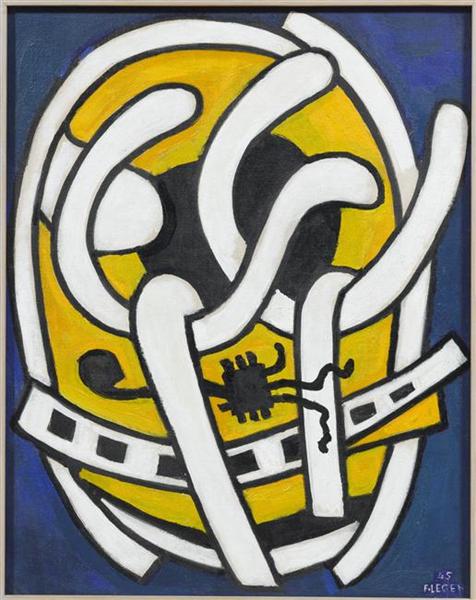Description
Fernand Léger's work "Both handlebars" (1945) is a fascinating example of the characteristic visual language of this outstanding artist, whose career covered various artistic currents, from Cubism to Modernism, always with an approach to the representation of contemporary life and the human form. In this painting, Léger explores his particular vision of reality, intertwining abstract elements with a distinctive geometric order that characterizes it.
When observing the composition, a careful construction of shapes and colors that suggest a narrative, although not explicitly. The work presents a series of elements that seem to flow and turn, evoking the sensation of movement. This dynamic is especially palpable in the disposition of the handlebars, which appear in the foreground, almost as protagonists, emphasizing the idea of interconnection and duality. Each handlebar can be seen as a symbol of direction and trip, possibly representing the elections and paths that are presented in life.
The color palette in "both handlebars" is notable for its vibrant use of primary tones, including intense, yellow and red blue. This color use not only adds visual wealth, but also creates a contrast that guides the viewer's gaze through the work. Léger was a master In using bright colors to transmit emotions and sensations, and in this piece, this ability becomes evident. The colors are not only aesthetically pleasant, but also establish an almost festive environment, while suggesting an emotional depth.
Although the work does not include traditional human figures, the handlebars can be interpreted as representations of humanity itself, symbolizing the collective journey of the post -war society. In this sense, the historical context of the creation of this painting is relevant; 1945 marked the end of World War II, a period of intense suffering and transformation. Léger, being an artist committed to his time, could have been reflecting on the rebirth and reconstruction in the world, encapsulating in his work a hope of renewal.
Léger's style, known for his focus on abstraction, the use of volumetric forms and his interest in the representation of the machine and modernity, clearly manifests itself in "both handlebars." His ability to merge the geometric and the figurative resonates with other works of his vast career, such as "the great adventure" and "man in the city", where he also plays with the idea of modernity and urban development. In this way, "both handlebars" can be seen as a continuation of their aesthetic exploration of the issues of identity and contemporary experience.
In conclusion, "both handlebars" not only reflects the distinctive style of Fernand Léger, but also invites a deep reflection on the state of the world in which it was created. Through his ability to intertwine color, shape and symbolism, Léger makes this work resonate with the viewer, reminding us of the importance of direction and the way in a period of transformation. Painting is both a celebration of life and a meditation on the challenges of its time, encapsulating the very essence of Léger's art.
KUADROS ©, a famous paint on your wall.
Reproductions of paintings handmade oil, with the quality of professional artists and the distinctive seal of KUADROS ©.
Art reproduction service with satisfaction guarantee. If you are not completely satisfied with the replica of your painting, we refund your money 100%.

